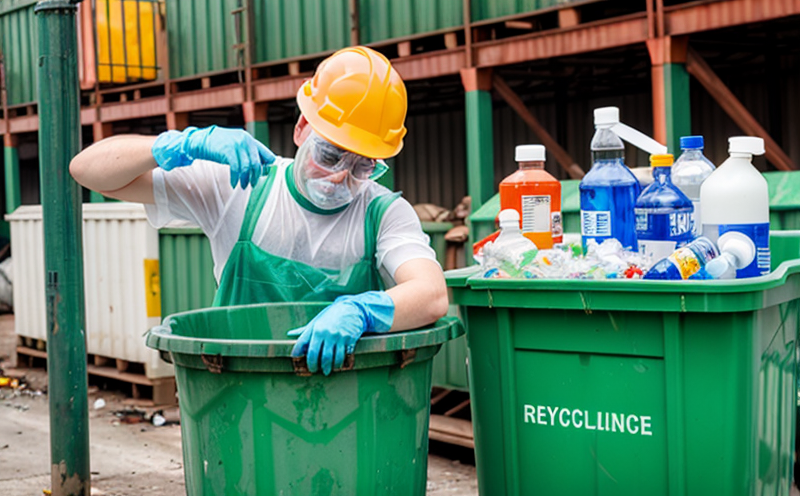EN 14899 Waste Sampling and Characterization Testing
The European Standard EN 14899 specifies the methods for sampling waste streams intended for recycling or recovery, as well as the procedures to characterize these materials. This standard is crucial in ensuring that waste management processes are carried out efficiently and effectively, aligning with environmental regulations and sustainability goals.
Waste sampling involves the selection of representative samples from a larger batch of waste material. This process ensures that the characteristics of the entire batch can be accurately determined based on the sample analysis. The standard outlines specific procedures to minimize the risk of sampling bias and ensures that the sampled material is representative of the total waste stream.
Characterization testing, according to EN 14899, involves a series of analytical methods aimed at determining the composition, physical properties, and other relevant attributes of the waste. This includes chemical analysis for identifying contaminants or valuable components, particle size distribution tests, density measurements, and more. The goal is to provide detailed information that can help in making informed decisions about how best to treat, recycle, or recover the waste material.
The standard emphasizes the importance of proper sample preparation and handling techniques to ensure accurate results. This includes considerations such as temperature control during sampling, use of appropriate containers, and minimizing contamination from external sources. By following these guidelines, laboratories can produce reliable data that contribute significantly to the success of recycling operations.
EN 14899 applies not only to municipal waste but also to industrial and commercial waste streams. Its comprehensive approach ensures that all types of waste are handled in a way that maximizes resource recovery while minimizing environmental impact. The standard is particularly useful for facilities dealing with mixed waste fractions, as it provides detailed guidance on how to separate and characterize these materials accurately.
The implementation of EN 14899 helps ensure regulatory compliance and supports the development of effective waste management strategies. By adhering to this standard, organizations can demonstrate their commitment to sustainable practices and contribute positively to global environmental goals.
Benefits
Adhering to EN 14899 offers numerous benefits for quality managers, compliance officers, R&D engineers, and procurement professionals alike. These include:
- Enhanced Compliance: Ensures that waste management processes comply with international standards, thus reducing the risk of legal penalties.
- Informed Decision Making: Provides detailed information about waste characteristics, aiding in efficient resource recovery and recycling strategies.
- Improved Efficiency: Streamlines sampling and characterization procedures, leading to faster decision-making processes.
- Environmental Impact Reduction: By accurately characterizing waste, organizations can minimize environmental impact through optimized recycling processes.
- Enhanced Reputation: Demonstrates a commitment to sustainability and responsible waste management practices, enhancing the organization's reputation.
- Cost Savings: Efficient resource recovery and reduced contamination in recycled materials lead to significant cost savings over time.
In summary, EN 14899 plays a vital role in supporting sustainable waste management practices, ensuring compliance with international standards, and driving innovation in recycling and recovery technologies.
Customer Impact and Satisfaction
The implementation of EN 14899 has a direct impact on customer satisfaction by providing reliable data that supports informed decision-making. Customers can trust the quality of recycled materials produced from properly characterized waste streams, leading to increased confidence in purchasing decisions.
By adhering to this standard, organizations demonstrate their commitment to sustainability and responsible waste management practices, which is crucial for maintaining long-term customer relationships. The detailed information provided by EN 14899 helps customers understand the quality of recycled materials, thereby enhancing overall satisfaction levels.
In addition, compliance with international standards like EN 14899 can open up new markets and opportunities for customers. By meeting these standards, organizations become more attractive to environmentally conscious consumers who value sustainability in their purchasing decisions.
International Acceptance and Recognition
EN 14899 is widely recognized internationally as a robust standard for waste sampling and characterization testing. Its acceptance by various countries underscores its importance in the global waste management industry.
The standard has been adopted by several European Union member states, reflecting its significance in regulatory frameworks across borders. Additionally, EN 14899 is used globally by organizations involved in recycling, resource recovery, and environmental protection initiatives. This widespread acceptance highlights the standard’s relevance and reliability in addressing complex waste management challenges.
International recognition of EN 14899 also contributes to the development of harmonized practices across different regions. By aligning with this standard, countries can ensure that their waste management processes are consistent with global best practices, fostering a more integrated approach to environmental protection.





